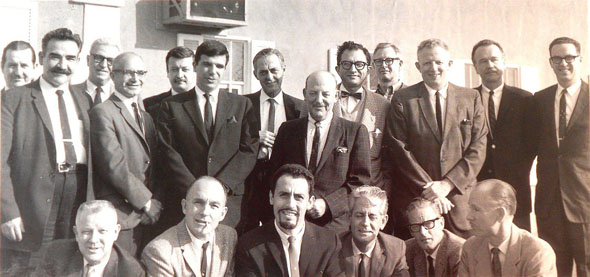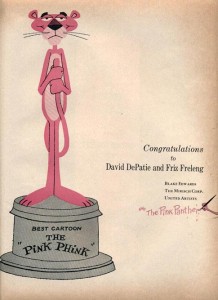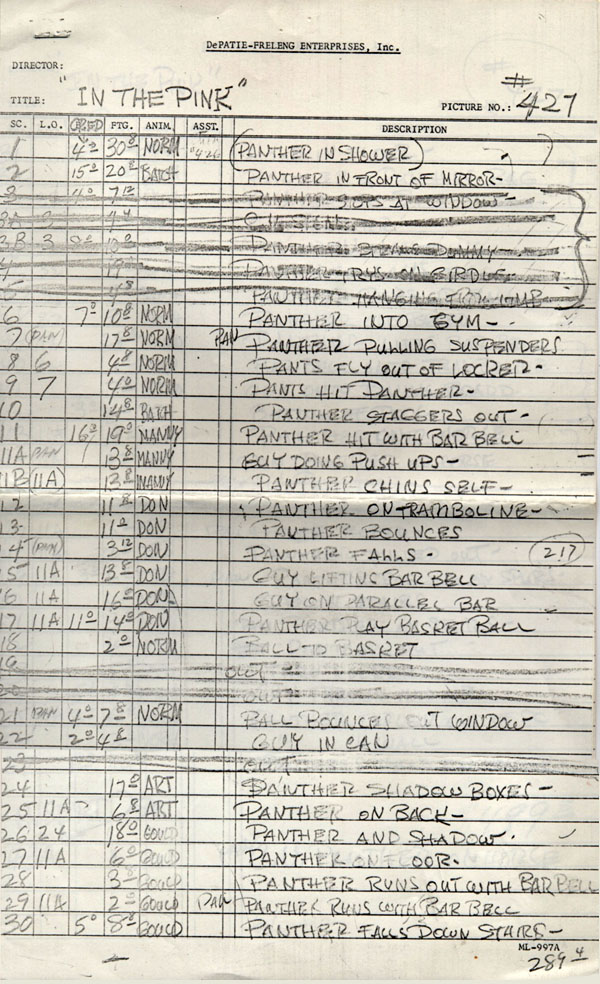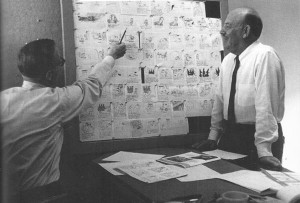
Here’s a wonderful surprise for you readers — a draft from the DePatie-Freleng studios!
By the mid-‘50s, the advent of television gave animators an option to work in commercials or in animated programming exclusively for the medium. Studio cartoons were still prevalent in theaters, but their business dwindled over time as the TV market prospered. After MGM closed its animation department in the summer of 1957, Bill Hanna and Joe Barbera formed their own studio, producing television cartoons. They recruited animators from MGM to their studio—Ken Muse and Mike Lah, for instance. Soon, other staffers from different studios joined, as well.
Mike Maltese, the main writer in Chuck Jones’ unit at Warners, contacted Barbera for a job at his studio and left in October 1958. Warren Foster, another principal writer in Friz Freleng’s unit, left to work for John Sutherland Productions, but joined Maltese at Hanna-Barbera on Huckleberry Hound. Jones and Freleng served as their own storymen, while Tedd Pierce stayed in Bob McKimson’s unit until he left for Walter Lantz in the early ‘60s. Jones contacted animator Ward Kimball at Disney’s, desperate for a writer. John Dunn, a story artist for Kimball’s Tomorrowland specials for the Disneyland television program, came to the studio on February 1960.By this time, Warner Bros. agreed to keep the studio open for another three years; a weekly, half-hour Bugs Bunny Show proved substantial. As their new writer, Dunn wrote the bridging sequences—alternating directorial duties between Jones, Freleng, and McKimson—used in between three previously released cartoons. The studio produced commercials, often with their established characters, and industrial films, which merged with the animation studio. David DePatie, son of vice president/general manager E.L. DePatie, operated the organization.
While The Bugs Bunny Show wrapped up production around the spring of 1962, DePatie was given orders to finish the show and close the studio. Key personnel from Warners would soon depart; Jones’ involvement with UPA in selling Gay Purr-ee, a screenplay co-authored by his wife Dorothy, led to his termination from Warners when it became the film’s distributor in July 1962. Freleng left the studio in November of that year, to work with Hanna-Barbera as a story supervisor on the team’s first feature Hey There, It’s Yogi Bear. Freleng took Dunn along with him. McKimson directed inserts for The Incredible Mr. Limpet, a Don Knotts vehicle, which helped keep the studio going until the spring of 1963, when its animation department officially closed.

The last days of Warner Bros. Cartoons – “The Incredible Mr. Limpett” crew with Freleng and Dunn (back row, l to r): Bob McKimson, Bill Tytla, Harry Love, Tom O’Loughlin, Dave De Patie, Treg Brown, Friz Freleng, Lee Halpern, Bob Matz, Lew Irwin, Hawley Pratt, Bill Orcutt; (front row, l to r): Gerry Chiniquy, Art Leonardi, O. B. Barkley, John Dunn and Virgil Ross
After the closure, Warners offered DePatie a position in their live-action television division as an executive producer, but he decided to head his own business. Freleng returned to the studio after the closure, and the two formed DePatie-Freleng Enterprises, renting the Warners animation building in Burbank. They hired many artists, most of whom previously served during a certain period; for instance, animator Norm McCabe directed several black-and-white Looney Tunes during the early ‘40s.
 Comedy screenwriter/director Blake Edwards, a friend of DePatie’s, gave him the script for an upcoming film The Pink Panther, thinking the name was appropriate for an animated character somewhere in the live-action film. Edwards planned to shoot some sequences in Rome, leaving DePatie and his animation team with the idea. Freleng’s layout artist Hawley Pratt created the design for the Pink Panther, which, at this poraint, was used on the studio’s letterheads and business cards.
Comedy screenwriter/director Blake Edwards, a friend of DePatie’s, gave him the script for an upcoming film The Pink Panther, thinking the name was appropriate for an animated character somewhere in the live-action film. Edwards planned to shoot some sequences in Rome, leaving DePatie and his animation team with the idea. Freleng’s layout artist Hawley Pratt created the design for the Pink Panther, which, at this poraint, was used on the studio’s letterheads and business cards.
When Edwards arrived back from Rome, he previewed the footage for DePatie, and proposed that the Panther appear in the main title sequence, as the character interacts with the names involved. It met with a tremendous reaction when previewed at the Village Theater in Westwood. DePatie convinced the Mirisch Company, the distributor of the film, and United Artists to sign a contract for animated shorts starring the Pink Panther. The first entry, The Pink Phink, won an Academy Award for Best Cartoon of 1964 — a rare instance for an animation studio to win for its first release. John Dunn wrote the story for the cartoon, and continued to work on countless projects for the studio, including their television programs.
Warners composer Bill Lava composed much of the music in the DePatie-Freleng cartoons, including a series starring The Inspector, based on the protagonist of the Pink Panther film. Walter Greene took over the musical duties around 1966. Shortly thereafter, DePatie-Freleng Enterprises re-located to the Union Bank building in Sherman Oaks. As a result, the studio wasn’t able to secure either musician; by the time of Pink Posies, the 27th Pink Panther, different snatches of Lava and Greene’s musical cues—most of which used Henry Mancini’s theme from Edwards’ film — from earlier entries are used throughout much of the Panther’s films. (Extinct Pink, slated to be the last Panther release in 1969, is an exception, using Doug Goodwin’s music from The Ant and the Aardvark series.)
The draft for In the Pink, the 29th Pink Panther cartoon, was recently found in the collection of Pete Alvarado, the film’s background artist. Formerly an assistant animator for Disney, he worked as a layout and background artist for Chuck Jones at Warners in the mid-‘40s and early ‘50s. He shifted to the McKimson unit as its chief layout artist. His background work in DePatie-Freleng occurred after a pause in his animation career, as Alvarado gravitated towards comics, coloring books and other animation-related merchandising art for Western Publishing.Alvarado left Disney for New York to seek other employment in the late ‘30s, and found himself drawing adventure comics and funny animal stories for Funnies Inc. and Timely Comics (later Marvel), returning to Disney’s after eighteen months. During his time in the Jones unit, he contributed to the Roy Rogers newspaper strip with Tom and Charles McKimson. He also drew newspaper strips of Gene Autry, Little Lulu, Mister Magoo, Yogi Bear, and the Flintstones, among many. He also continued drawing funny animal stories for Dell Publishing, drawing Disney, Warners, Hanna-Barbera and Walter Lantz characters.
The animators credited on the draft are present in the main credits, though the first scene of the Pink Panther emerging from the shower (credited to Norm McCabe) is lifted from Pink Panic, released a few months earlier. The draft also indicates omitted scenes in the beginning, including an unused gag with the Pink Panther attempting to wear a girdle to appear thin, before having the notion of joining a gym.
In the film, animators Don Williams and Manny Gould worked exceptionally within the restraints of limited animation; examples of this are Williams’ animation of the Panther bouncing on a trampoline and skipping rope, and Gould’s scenes of him struggling with a barbell. It’s interesting to note Art Leonardi is credited with only two shots in the film, during the shadow boxing sequence, while Manny Gould finishes the rest of the footage.



There will not be a breakdown for next week. In addition to my regular job, I’ve been working on a local independent feature, editing different sequences. It’s been exhausting trying to keep up, but I shall return…
Enjoy, everyone!
(Thanks to Jerry Beck, Michael Barrier, Greg Duffell, Mark Arnold, Charles Brubaker, Didier Ghez, and the Pete Alvarado Estate for their help.)




 DEVON BAXTER is a film restoration artist, video editor, and animation researcher/writer currently residing in Pennsylvania. He also hosts a
DEVON BAXTER is a film restoration artist, video editor, and animation researcher/writer currently residing in Pennsylvania. He also hosts a 



















































































I’ve observed that I have a harder time differentiating animators when there’s no dialog. It’s really interesting how an animator’s style comes out simply for how they move a character when they talk, at least in the classic cartoons.
One of the many joys in the weekly savoring of BAXTER’S BREAKDOWNS is the acknowledging of some unsung heroes, long overdue spotlights on some long overlooked talents. Well, here’s a quick but heartfelt thank you to you, Devon, for all the work you pour into these things. We know this is a labor of love, but it’s still labor and I know so many of us appreciate it as well as your thoughtful insights on the good solid research.
Love that you focus on a variety of subjects from a variety of eras, studios, etc. Hey, and I love that we were able to see the breakdown of a DePatie-Freleng toon! Make good use of the break, and we look forward to seeing BREAKDOWNS return!
Very interesting post today, Devon! I’m always up for more DFE history on this site…
It was interesting to read of the evolution of these cartoons. I only became aware of GAY PUR-EE when I saw a coloring book with that title. I’d never seen these characters before and, then, the film came to TV and I enjoyed it on our CBS affiliate. It was a great late night of cartoons long before there was any such network that aired such things ’round the clock, ending with a vintage PEPE LE PEW cartoon just before the 11:00 news.
A lot of the VOSFX (Voice Over Sound Effects) in the Pink Panther cartoons and well as in Roland and Rattfink’s first cartoon Hurts and Flowers were created by Mel Blanc including the shrieking “AAAAAAAAH!!!” Scream originally used in the WB cartoon Boston Quackie and my favorite the “Yodeling Yeow” scream
This is a wonderful surprise! I had no idea animators draft for a DFE cartoon existed. Nice to see, indeed!
Since Devon didn’t mention it, the sheets show Ted Bonnicksen and Warren Batchelder also animated parts of the cartoon.
Alvarado was back home in Los Angeles by the end of April 1940 as he shows up in the census return there.
I’ll admit I was intrigued to see a breakdown for this Pink Panther short, mainly for such stylistic character designs I thought would be awkward to distinguish. But after this effort, it’s interesting to see the slight drawing approach from Leonardi and Gould in tackling the titular character.
I’ll look forward to Baxter’s next breakdown after his break.
Nice to see a breakdown for a DFE short! Many thanks, Devon!
Can anybody indenitfy the scenes Don Williams animated on “Nine Lives of Fritz The Cat”. I have a hard time desiphiring who animated what especially on films from the 70’s